| GENERAL
INTRODUCTION
1.
By "Norse mythology" we mean the information we have
concerning the religious conceptions and usages of our heathen
forefathers, their faith and manner of worshiping the gods, and also
their legends and songs about the gods and heroes. The importation of
Christianity drove out the old heathen faith, but remnants or
memories of it long endured in the superstitious ideas of the common
people, and can even be traced in our own day.
There
has never been found on earth a tribe of people which did not have
some kind of religion, but the lower the plane of civilization on
which the people are found, the ruder and less pleasing are their
religious ideas. Religions consequently change and develop according
as civilization goes forward. One can, therefore, learn much by
knowing the mythology of a race, since it shows us what stage the
people in question have attained in intellectual development, what
they regard as highest and most important in life and death, and what
they regard as good or evil.
Sun-worship
and Nature-worship. — We can easily perceive that a belief in
counseling and controlling gods presupposes a far higher civilization
than savage people in their earlier history possess. Religious ideas
proceed partly from soul belief, belief in the continued life of the
soul, and partly from the belief that nature is something living,
peopled by mysterious beings which control regular and irregular
changes in nature upon which man feels himself dependent. Such beings
are often designated by the Greek word Demons. These
nature-demons make themselves plainly known through the roaring of
the storm, the rippling of the water, or the wind's gentle play with
the tree-tops. But races in the childhood period of their development
cannot hold fast to a belief in life apart from bodies. Demons,
therefore, are thought of in bodily form — as men or beasts. At the
same time man feels his helplessness and powerlessness in the
presence of Nature and its mysterious forces; he is prompted, then,
by offerings and supplications to gain friendly relations with these
powers which he with his own strength cannot over- come. In this we
begin to find the first germ of divine worship which is capable of
subsequent development, since ever increasing domain is 'given to the
single demon. With the advance of civilization there is developed in
the place of the belief in demons a belief in mighty gods, who are
thought of as beautiful and perfect human forms.
Greek
and Norse Mythology. — With the more developed heathen people
there is always an exact correspondence between the nature of the
country, the character of the people, and their religious belief.
There is, therefore, a striking distinction also between Greek and
Norse mythology. The Greek is bright and pleasant, like the country
itself; the gods are thought of as great and beautiful human forms
who are extolled not merely as gods, with offering and worship, but
also as inspired Greek artists and poets, producers of statues and
songs, the equal of which the world has scarcely seen. Norse
mythology as we know it from the latest periods of the heathen age
is, on the contrary, more dark and serious, and when it lays the
serious aside it often becomes rude in its jesting. Norsemen felt the
lack of talent for the sculptor's and painter's art, although they
were really clever in carving wood; their idols were as a rule merely
clumsy wooden images embellished in various ways. Their religious
faith, on the other hand, has called forth poetry which in its way is
by no means inferior to the Greek; and our forefathers' view of death
and particularly their teaching about Ragnarok, concerning which we
shall speak later, can rightly be preferred to the Greeks' faith in a
miserable shadow-life in a realm of death (Hades).
Why
We Teach Norse Mythology. — For us Norse mythology has in any
case the advantage of being the religion of our own forefathers, and
through it we learn to know that religion. This is necessary if we
wish to understand aright the history and poetry of our antiquity and
to comprehend what good characteristics and what faults Christianity
encountered when it was proclaimed in the North. Finally, it is
necessary to know the most important points of the heathen faith of
our fathers in order to appreciate and enjoy many of the words of our
best poets. This is especially true concerning Oelenschlaeger and
Gruntvig, who not only have embodied large parts of the Norse
mythology in independent poetic works (as "The Gods of the
North," "Earl Hakon," "Scene from the Conflict of
the Norns and Acsir") but also often borrow from it in their
other works terms and figures which we ought to be able to
understand. To point to the antiquity of the North and to our
fathers' faith, life, and achievements was one of the poet's
principal means of awakening the slumbering national feeling at the
beginning of our century.
2. Oldest
Inhabitants of the North. — It is possible that it
was our ancestors who, several thousand years before the Christian
era, inhabited Scandinavia, in the stone age. Learned investigations
have in every case proved as most probable and reasonable that people
of the bronze age, both before and after the year 1000 B.C., belonged
to the same race as the Northmen of the iron age, so that our heathen
era stretches over a space of at least two thousand years. We must,
therefore, seek information about the
oldest
religious ideas of the North in prehistoric archeology, the science
which investigates and throws light upon every species of relic
preserved from antiquity. Here it is especially burial rites and the
placing in graves of objects supposed to be offerings which have
mythological significance.
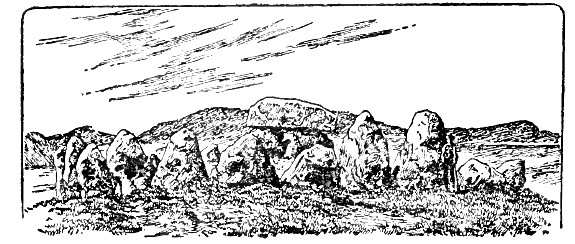
Fig.
1 — Round Burrows
a.
In the remains of the earliest stone age, the refuse heaps, no burial
places have been discovered; but from the latest stone age have been
found a great number of graves, round and long barrows, sepulchral
chambers (Figs. 1-3), and stone "chests," in which bodies
were laid unburned and supplied with the necessary implements, which
shows a belief in a continued life after death. Burned places and
remnants of pyres in the graves seem to indicate
offerings
to or for the dead, and hewn in the stones are often found certain
saucer-like depressions, wheels and crosses, which most likely have
religions significance (Fig. 4).
b.
In the bronze age, which ends some hundred years before the birth of
Christ, men long preserved burial rites from the stone age. Bodies
were not burned, but were placed in raised mounds in a tightly closed
stone setting or in chests of hollowed trunks of oaks. Later,
however, the burning of bodies became more and more common; ashes
were preserved in stone vessels or most often in clay urns within the
mounds; many times use was made of old mounds from the stone age. The
greatest number of our barrows contain, therefore, tombs from the
bronze age (Figs. 5-7). The reason for this change in the mode of
burial seems to be the rise of new ideas about life after death. At
first people believed in a continued life of the body, later they
burned the body to set free the soul. Likewise in the stone age men
deposited in the graves sacrificial gifts, handsomely wrought objects
for use or ornament, For decoration are used now also hooked crosses
and trefoils (Figs. 8-9). These emblems, whoa significance is not
known, are found used as sacred tokens ("religious symbols")
among all Indo-European peoples.
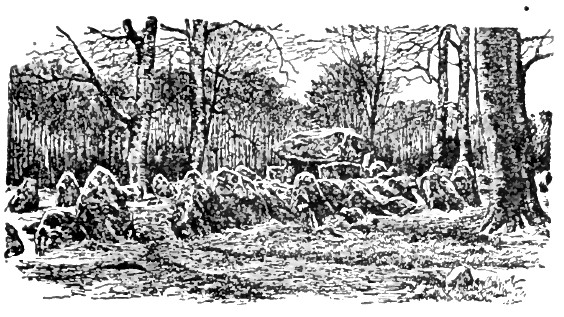
Fig.
2 – Long Barrows.
c.
The iron age begins probably sometime in the fourth century B.C. In
very ancient times; even, the Northmen had enjoyed commercial
relations with Asia and Greece. From about the time of Christ's birth
there begins a strong Roman influence, which, among other things,
gives the Gothic-Germanic people a peculiar alphabetic writing, the
Runes. The iron age stretches even into historic times; the last
division is the Viking time (c. 800-1000). In the course of the iron
age people again stopped burning bodies, since, as Snorri says, the
cremation-age was succeeded by the mound-age. Bodies were once more
regularly provided with objects for use — weapons and vessels for
food and drink. Discovery has been made of large and splendid
offerings (e.g. golden horns), urns with slain animals,
perhaps even altars upon which rude images1 of the gods
seem to have been raised (Fig. 10). Several other things from the
middle-iron-age will be touched upon in what follows; but we do not
see anything really definite, indicating belief in gods, until far on
toward Viking times.
3. Common
Norse Language. — At the beginning of the Christian
era, the Danes, Norwegians, and Swedes constituted but one tribe,
speaking the same language, Urnordisk, Primitive Norse. This
common language was preserved, with a succession of natural
transitions and changes, to be sure, to about the year 1000. In
Viking times this was called den danske Tunge, "the
Danish Tongue," and from it the separate Norse languages have
gradually been developed. It is also probable that the Northmen had
the same heathen religion in all the main points; even in the worship
of the gods there has been but little difference in the different
provinces.
Gothic-Germanic
Race. — We may even go a step farther back, for it can be
established in many ways that Northmen, Germans, and Englishmen also
were once one great race, which is usually called the
Gothic-Germanic, and this Gothic-Germanic race has again a common
origin with most of the European peoples (e.g. the Greeks),
and with the inhabitants of Persia and India.
Indo-Europeans.
— We must then picture to ourselves a "primitive people"
whose original place of abode we cannot determine, but from which
these related peoples have through long periods been developed. This
primitive people as a matter of course had certain religious ideas,
and it is probable that we may be able to find traces of the original
divine faith in the Indian, Greek, and Norse mythology; and this is
actually the case. The linguists who are occupied with comparisons
between the languages of the different Indo-European races have been
able to establish many such points, but here we must be content with
bringing forward a few examples.
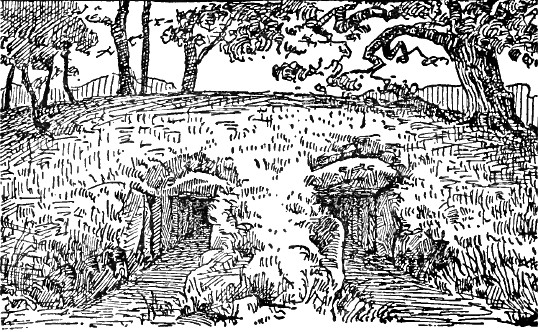
Fig.
3 – Sepulchral Chambers, or Cairn.
Aesir.
— The general name for the gods was, among the Northmen, Aesir,
which is developed from the older Anser. Corresponding forms
are found in most of the related languages. The Heaven-God was called
among the Indians Dyâus, by the Greeks Zeus, by the Romans Ju-piter.
The Germanic people believed in a god whom they
called Tiu while there is found in the Norse religion the name Tyr
(preserved in Dan. Tirsdag, Eng. Tuesday). In the
oldest
Norse language this word must have been TiwaR.2
But all these names undoubtedly spring from a common basal form,
which signifies "the bright one" or "the shining one,"
and which consequently may have designated the god of the heaven or
the sun.
Tyr,
Odin, Thor. —
Gradually, as the Indo-Europeans scattered and in the course of time
settled in different regions with greatly differing climate, they
gave to their god of heaven many epithets, according to the nature of
the country in which they had settled. The Gothic-Germanic people
called him now by the original name, now Wothanar or ThonaraR
("the blowing one," "the thundering one"), and it
was not long before they forgot that these names were only appendages
to the old heavengod's name. Now they enumerated as many gods as
there were names, and thus arose, among other things, belief in the
three divinities, Tyr, Odin, and Thor. (The Germans said Wodan and
Donar. In the North we have little or nothing of the worship of Tyr;
Frey takes the place of this god.) Consequently new divinities and
new religious ideas seem to have arisen among our forefathers
according to the rule that
the god's epithet or title is separated from his name and then
designates an independent personal being.
Since this is applicable to a god, one can easily imagine that
something similar can be the case with many other points in
mythology.
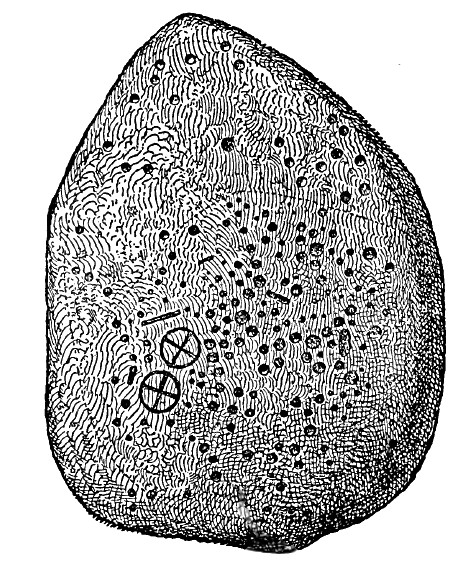
Fig.
4 – Stone with Saucer-like Depressions, Wheels and Crosses.
Common
Myths — But a direct comparison also between the heathen faiths
of the Indo-European people shows that many single points in their
religions (myths) correspond. Myths about a world-tree are
found among both Indians and Northmen. The highest god among the
Indians. Greeks, and our forefathers alike is armed with a
sure-striking missile in his capacity of the thunder-god, whether
this he represented plainly as a thunderbolt (lightning-flash), a
hammer. or a club.
Cæsar
and Tacitus — Besides this we know but little with certainty
about particular points in the mythology of the oldest
Gothic-Germanic people; and so it is also with regard to the religion
of the Northern people in the first centuries of the Christian era,
for they have left no written records behind them. We have already
spoken of what we can learn from ancient finds, not a few important
points of information, especially the latter in his historical books
and in his brief account of Germany.
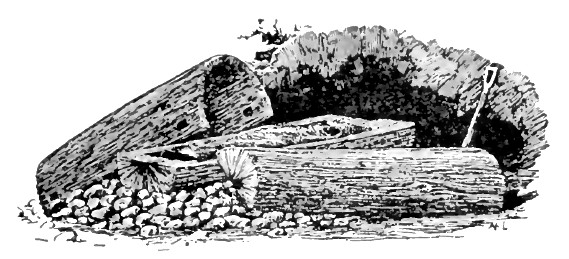
Fig.
5 – Coffins from the Bronze Age.
4. Runes.
— But about the third century after Christ the
Gothic-Germanic people soon reached also the Northern races, where
they were scratched upon objects in common use, as combs, clasps,
weapons, and drinking or sacrificial horns. Here belong the
aforementioned golden horns from Gallehus in southern Jutland. These
were found in 1639 and 1734 and had a value in our money of about
17,000 kroner ($4,760). At the very beginning of our century they
were stolen on account of their great value and melted over, so we
now must content ourselves with drawings and casts of these splendid
monuments of antiquity, which may have been a sacrificial gift. They
consisted of two smooth golden horns of very fine gold with an outer
casing of tight-fitting rings likewise of gold, on which there were
engraved figures and ornaments, and between these again there were
raised figures firmly soldered (Figs. 11-13). Many attempts have been
made to interpret these pictorial representations, which easily have
a religious significance. Worsaae, our renowned archæologist, was of
the opinion that one horn represented life in hell (the serpents),
the other life in Valhalla (the stars), which however is wholly
uncertain. Along the uppermost ring of one horn one may read in the
primitive Norse language:
ek
hlewagastiR
holtingaR
horna tawido,
that
is: I, Lægtæst, Molt's son (or, from Holt), made the horns.
Rune-Stones.
— Somewhat later men began to use runes for inscriptions on
bowlders, which were placed in or oftenest upon grave mounds or
elsewhere, as memorials for the departed. Such rune-stones are found
in Denmark, Norway, and Sweden from different ages, but with us Danes
only from epochs between 800 and 1070,3 the oldest
therefore even from the heathen time. Rune-stones give the
earliest and surest contribution to our knowledge of Aesir-faith in
the North.
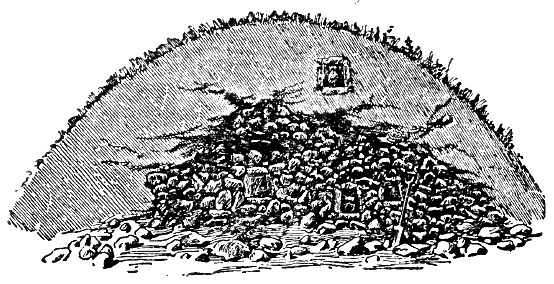
Fig.
6 – Grave Mound with Urns.
Thor
on Rune-stones. — On the Glavendrup stone from about 900, which
contains the longest Danish runic inscription, we read, after the
memorial words themselves, the following:
May
Thor consecrate these runes!
On
another Danish rune-stone the invocation comprises the whole
memorial, for on the margin of the stone is engraved:
May
Thor consecrate this monument!
Such
a place consecrated or dedicated to the gods is called a Ve or Vi,
which name we have preserved in Odense (i.e.
Odinsve) and Viborg. On the Glavendrup stone, which is raised over
the Chieftain Alle, the latter is called "Vierne's honorable
servant," and on a south Jutland rune-stone Chieftain Odinkar's
daughter calls herself Vi-Asf rid.
Thor
the Chief God. — Only on these two stones is the name of the
god of thunder expressly given, but on others we find engraved
trefoils, quatrefoils ("hooked crosses"), or hammers (Fig.
14), which is an evidence of the fact that Thor at this time was
the chief god of the Danes; and this same thing we can establish
in many other ways, and for the rest of the North also. This is shown
by the many compound person and place names in which Thor's name is
the first member (e.g. Thorsteinn, Thorbergr). Finally, it can
be emphasized that when the Gothic-Germanic people translated the
Latin names for the days of the week, in the fifth day, which in
Latin is called Jupiter's day (dies Jovis), they translated
Jupiter by Thor (Icel. Thorsdagr, Dan. Torsdag,
Ger. Donnerstag).
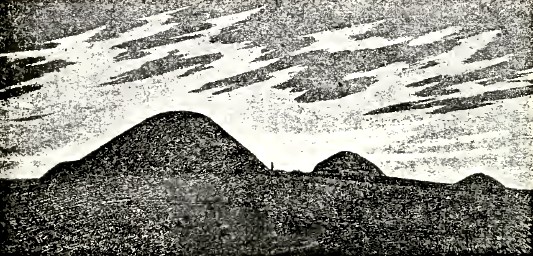
Fig.
7 — Row of Grave Mounds.
Odin
and Frey. — Together with Thor, Odin and Frey were especially
worshiped, and some evidences of this fact are found upon
rune-stones. Odin, however, was not understood as the mighty supreme
god among the common people. He is so represented only in
Norwegian-Icelandic poetry, and it was among the Germanic people
dwelling southward that Odin-worship played an important part at an
early period.
5. Iceland.
— There are, therefore, but few details known to
us
of our forefathers' religion at the beginning of Viking times. But
from about the year 900 and later we have full and rich information
about the religious ideas of the Northern people in the
Norwegian-Icelandic literature.
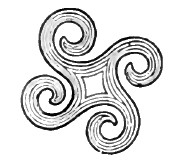 |
 |
| Fig. 8 – Quatrefoil or
Hooked Cross. |
Fig. 9 — Trefoil |
Mythological
Poetry. — When different families of the Norwegian nobility at
the close of the 9th century began to settle in Iceland, they carried
with them from the mother country not only their old religion hut
also a store of songs and traditions about the gods and heroes. This
poetry was preserved faithfully by oral transmission, from generation
to generation. Poetical activity soon evinced itself among the
Icelanders themselves, and gradually a great and rich literature
developed, which became far more important and more truly presented
original and national ideas than that of the rest of the Scandinavian
country, whose intellectual productions took on through Christianity
a foreign, learned-Latin stamp. We can, therefore, expect to find
among the Icelanders fuller information about the old faith than
elsewhere, and such is also the case. In the Norwegian Old Icelandic
poetry the Norse religion is worked together into a whole, which
comprises the creation of the world, the relation of gods to men in
life and death, and finally the downfall of the gods and of the world
at Ragnarok, after which there shall come a new heaven and a new
earth where men are judged after their uprightness and good conduct,
and not for their bravery alone.
Odin.
Chief God. — An essential point which we ought to note here is,
as touched upon before, that Odin in this poetry is conceived of
as the chief god, before whom the others, both gods and
goddesses, must bow.
If
we now, in what follows, wish to make a coherent presentation of the
religion as we find it in Norwegian-Icelandic literature, we must in
the first place remember well that Denmark and Sweden hardly had the
same faith, viewed as a whole, even if there are points of conformity
in essentials. It appears among other things from the myths of the
gods which Saxo has presented to us in the first' books of his Latin
history of Denmark, that various details in the teachings about the
gods are told otherwise here (in Denmark) than in Iceland, and that
we have traditions to which nothing in Iceland corresponds and vice
versa. But in the next place the contention is made, especially by
the Norwegian philologist Bogge, that a great many things in
mythological poetry, through contact with the Celts and others in the
Viking expeditions, have been strongly influenced by Christianity,
yes, even by Jewish and Græco-Roman ideas. Against this view,
however, many and important objections are raised; but no one can
deny that Christianity can and must have had in any case some
influence upon the later development of Norse mythology. Finally, it
cannot be strongly enough emphasized that most of the myths and
hero-sagas which are retold in what follows must not be understood as direct
testimony concerning our fathers' belief, but
generally
are only a poetically interpreted and modified portrayal, the
material for which is most certainly derived from the belief of the
people.
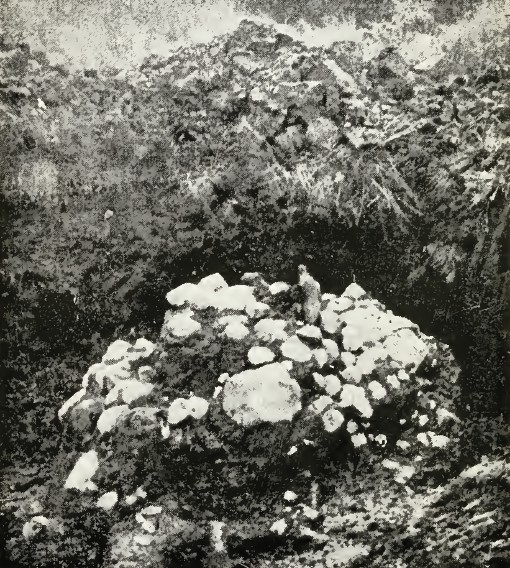
Fig. 10 – Altar from
the Iron Age.
Therefore
it is Norwegian-Icelandic mythology such as developed in Viking times
and soon afterwards (800-1100) which we know best, and it is
all we know connectedly. We must see first, then, from what
sources we derive this knowledge.
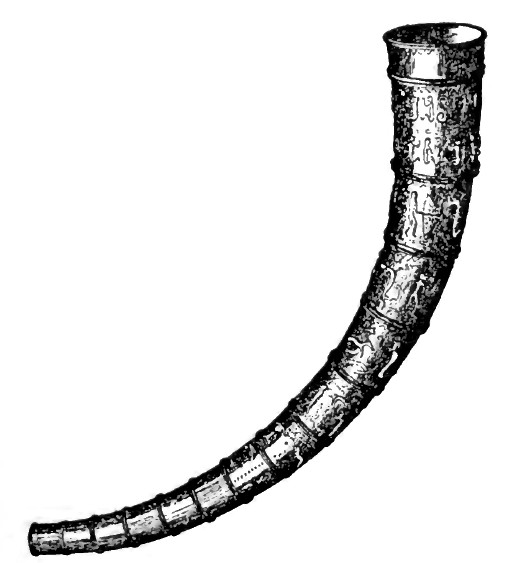
Fig
11. – A Gold Horn.
6. Eddic
Poems and Scaldic Lays. — The oldest and most
important sources are the old Norwegian-Icelandic poems. It is
customary to distinguish between the so-called Eddic Poems and the
Scaldic Lays.
The Eddic
Poems preserved in an Icelandic manuscript and
wrongly
called the Elder Edda were composed in the aforementioned period, in
the time of transition and of conflict between paganism and
Christianity. They are of unknown authorship and treat partly
doctrines of the gods and the heathen view of life in connected form,
and partly the different sagas of gods and heroes which in the North
are usually given a mythological background. The most important of
the Eddic poems will be mentioned in the following pages.
The Scaldic
Lays come from authors whose names are mentioned.
The
oldest and best are from the same period as the Eddic Poems, but only
a few of them have a thoroughly mythological content — chiefly the
"shield poems," treating the myths which arc pictorially
represented on the fields of the shields, and the "Song of
Praise" to the chieftain whose lineage is traced up to the gods.
On the other hand they all contain in their poetic paraphrases, the
so-called Kenningar, allusions to mythology or legendary
history which presupposes that the myth or saga in question is known
to the hearer. When the gallows can be called by a poet "the
cool, windy steed of Signy's bridegroom," the hearer must in
order to understand the expression know well the legend of Hagbarth
and Signy and Hagharth's death on the gallows.
From
Iceland came likewise two important primary sources of Norse
mythology in prose, namely Snorri's Edda and the Saga of the
Volsungs.
Snorri
(d. 1241). — Snorri Sturlason was Iceland's most important
prose author and withal a clever Scald. In his historical
masterpiece, "Heimskringla," he used especially for matters
concerning the earliest time, old Scaldic lays as proofs for his
description, and therefore he acquired accurate and intimate
knowledge of their content: and as a Scald he of necessity completely
understood the substance and nature of the poetical paraphrases. He
then conceived the plan of committing his knowledge to writing, and
therefore he composed his Edda. This word is most closely defined as
"Poetics" or "Handbook for Scalds." The book
falls into three main divisions. The first, Gylfaginning,
'Delusion of Gylfi,' relates the story of a king Gylfi, who journeyed
forth to learn about the power of the Aesir. He disguised himself as
a wayfarer and came to a great hall in which were many people and
three chieftains, who sat each in his high seat, one higher than the
other. These he questioned about all the mythological relations, and
he received clear answers to all his inquiries. Within this framework
Snorri takes occasion to present a general view of the whole doctrine
of the gods, particularly following old poems which he frequently
cites in evidence. He mentions several of the Eddic poems still
preserved, but also some which we do not know now from any other
source.
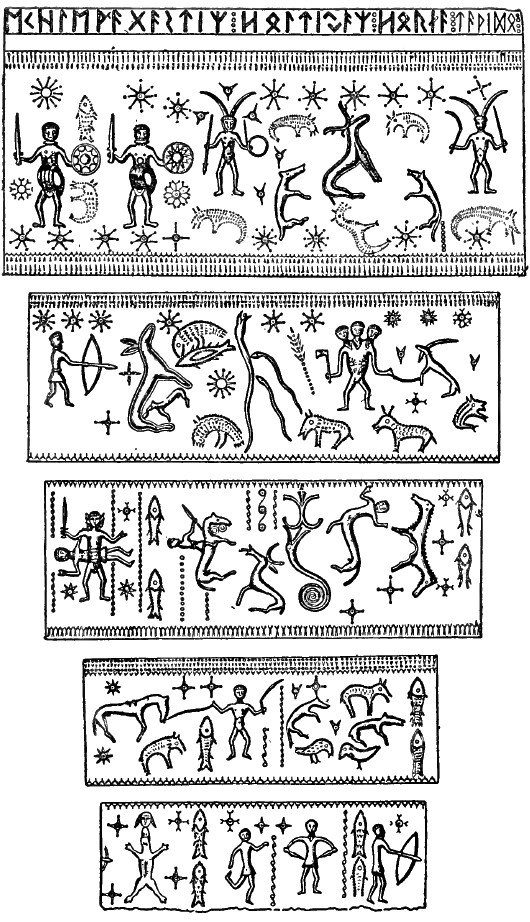
Fig. 12 – Pictures on
Gold Horns.
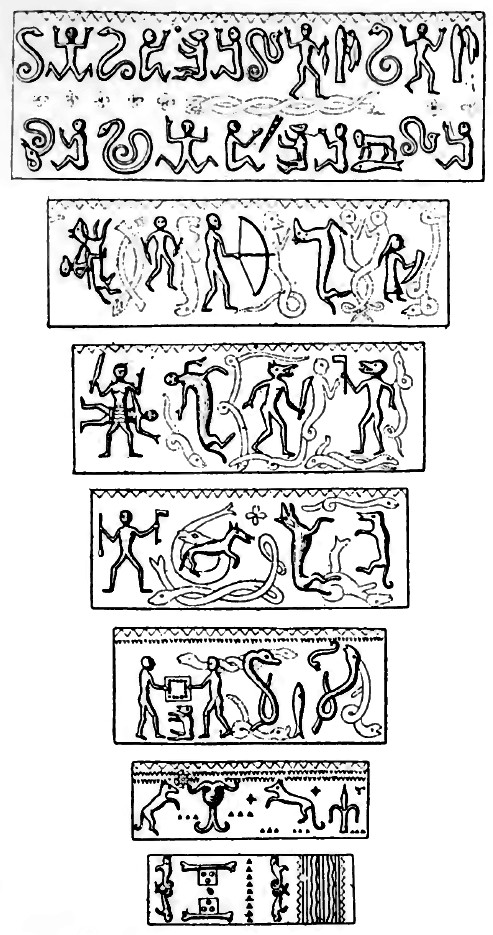
Fig.
13 – Pictures on Gold Horns.
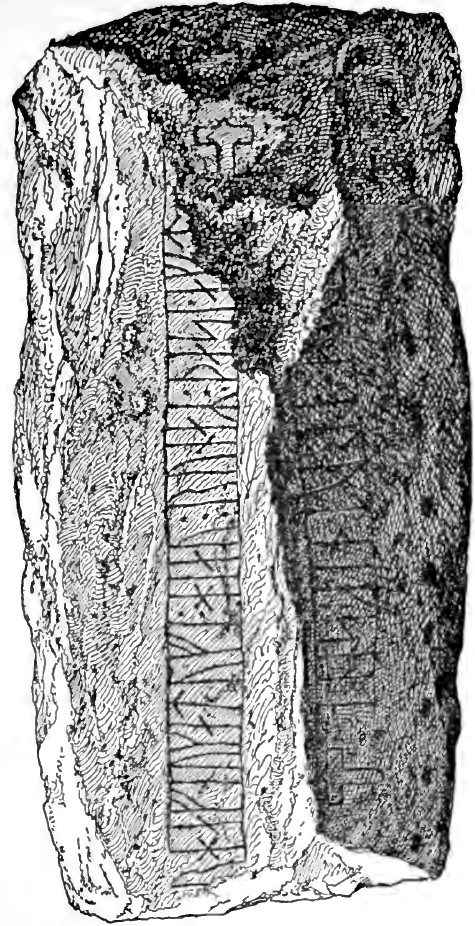
Fig.
14 – Laeborg Stone with Sign of Hammer.
The
second section, Skaldskaparmal,4 reviews and
explains the different poetic paraphrases. Where these allude to the
doctrine of the gods or to traditional history, the myths or
traditions in question are recounted and a number of scaldic verses
are cited as passages in evidence.
The
third section, finally, Hattatal,5 which is the
least important for the mythology, is a practical application of the
foregoing theory, since Snorri has composed a number of verses in
different meters, making use of the paraphrases which he has
explained in what preceded.
In
the introduction to the whole and in the arrangement of the material
one easily feels that Snorri has sought to bring about coherence in
the old traditions — perhaps involuntarily under influence of his
Christian faith — and tries to coin history out of myths and sagas,
since Odin is made into a prince versed in magic, dwelling originally
in Asia, but who later wandered to the North, where he became the
ancestor of the kings of the realm and was worshiped as a god. Snorri
advances the same view also in the first part of the Heimskringla,
the so-called Ynglinga Saga, which contains important but obscure
mythological information. 6
The
Saga of the Volsungs contains a connected prose version of the Sagas
of the Volsungs and Nibelung, an amplified re-narration of the Eddic
Hero-Poems; but here, as in Gylfaginning, it is apparent that
the unknown author had for his authority poems now lost.
But
in the other pieces of Icelandic prose literature also there are
given here and there important details about the heathen worship of
the gods and its forms. This applies both to the Heimskringla
(the attempt of the two Olafs to introduce Christianity into Norway)
and to not a few of the family-sagas. There are also found
mythical-heroic sagas in the style of the Volsunga Saga and romantic
sagas with mythological material.
8. Popular
Songs and Saxo. — In the German saga-poetry
Dietrich von Bern (Theodoric of Verona) plays the leading part,
and tales about him have also wandered to the North, where they are
treated both in Eddic poetry and in folk-songs. Meanwhile the same
theme is treated far more explicitly in the Thithrek Saga, which was
composed in Norway in the middle of the 13th century on the basis of
tales and songs of Low German merchants.
Folk-Songs.
— Finally, an important but late source is found in the ancient
ballads proper, which partly contain allusions to myths ("Tor of
Haysgaard," "The Youth Svendal," "Sven Vonved,"
"Rage and Else"), and partly treat whole saga-cycles ("The
Volsungs," "Hagbarth and Signe"). In several of the
magic songs also there are preserved many heathen ideas, while their
apparent Christian character is somewhat superficial. Here we can
also mention popular traditions and popular adventures and
especially popular usages, which have often preserved one or
another heathen reminiscence.
As
already remarked above, Saxo in his ancient history, the first nine
books of his works, retells and works in together a number of sagas
about the gods, heroes, and kings. In his work, which was finished in
the beginning of the 13th century, he has made use of both Danish and
Icelandic 'tradition for its foundation. The ancient history has
extraordinary mythological importance, but as a source it must be
used with the greatest caution. Saxo gives the same historical
interpretation to the whole that he does to any part and therefore he
has altered and rearranged myths and sagas when coherence seemed to
demand it. The old gods are interpreted as might be expected from a
religious author. Old songs are often quoted, but unfortunately in a
remodeled Latin version.
NOTE.
— Canon Adam of Bremen, who lived contemporaneously with Svend
Estridson, made a Latin account of the history of the Archbishop of
Hamburg, in which he also tells of the paganism of the Northern
countries. Of foreign sources which can throw light upon the
interrelation of myths among the Gothic-Germanic people can he named
the "History of the Goths," written by Jordanes, and the
"History of the Lombards," by Paulus Diaconus. Finally,
there are found important contributions on this point. in Old German
and Anglo-Saxon poetry, which is now purely heathen, now Christian
with a background of heathen ideas and expressions. In England are
found not a few pictorial representations with half-heathen content,
of which several will be used in what follows.
_______________________________________
1
In a single instance undoubted images of gods were found in certain
marsh-lands.
2
R answers to voiced S in older stages of the language.
3
Some younger stones from Bornholm and a single one from Skaane need
not be mentioned here.
4
Poetic Phraseology or Language of Poetry.
5
Enumeration or Tale of Meters.
6
"The Round World," History of the Scandinavian Races.
|

